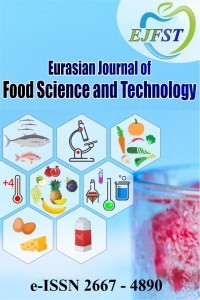Starch Based Sugar; Production, Usage and Health Effect
Starch Based Sugar; Production, Usage and Health Effect
Starch based sugar, high fructose syrup glucose syrup, sucrose,
___
- Andrade J.K., Komatsu E., Perreault H., Torres Y.R., Rosa M.R., Felsner M.L. 2016. In house validation from direct determination of 5-hydroxymethyl-2-furfural (HMF) in Brazilian corn and cane syrups samples by HPLC–UV. Food Chemistry 190: 481-486.
- Bocarsly M.E., Powell E.S., Avena N.M., Hoebel B.G. 2010. High-fructose corn syrup causes characteristics of obesity in rats: Increased body weight, body fat and triglyceride levels. Pharmacology, Biochemistry and Behavior. 97: 101–106.
- Chandrasekaran M., 2015. Enzymes in Food and Beverage Processing. pp 206-217. CRC Press.
- Chaplin M., Bucke C. 1990. Enzyme Technology.Cambridge University Press. http://www1.lsbu.ac.uk/water/enztech/starch.html
- Chen J., Nowakowski C., Green D., Hartel R.W. 2015. State behavior and crystal growth kinetics of sucrose and corn syrup mixtures. Journal of Food Engineering. 161: 1–7.
- Eke-Ejiofor J. (2015). Functional properties of starches, physico-chemical and rheological properties of glucose syrup made from cassava and different potato varieties. International Journal of Recent Scientific Research. 6, 4400-4406.
- Foresti M.L., Williams M.D.P., Martinez-Garcia R., Vázquez A. 2014. “Analysis of a preferential action of α-amylase from B. licheniformis towards amorphous regions of waxy maize starch”, Carbohydrate Polymers, 102, 80– 87.
- Hull, P. (2010). Glucose syrups: Technology and Application. Wiley Blackwell Publication.
- Jia D., Zhou L., Zheng Y., 2017. Properties of a novel thermostable glucose isomerase mined from Thermus oshimai and its application to preparation of high fructose corn syrup. Enzyme and Microbial Technology. 99: 1-8.
- Le M.T., Frye R.F., Rivardb C.J., Cheng J., McFannd K.K., Segal M.S., Johnsonb R.J., Johnson J.A. 2012. Effects of high-fructose corn syrup and sucrose on the pharmacokinetics of fructose and acute metabolic and hemodynamic responses in healthy subjects. Metabolism Clinical And Experimental. 61: 641 – 651.
- Melanson K.J., Zukley L., Lowndes J., Nguyen V., Angelopoulos T.J., Rippe J.M. 2007. Effects of high-fructose corn syrup and sucrose consumption on circulating glucose, insulin, leptin, and ghrelin and on appetite in normal-weight women. Nutrition. 23: 103–112.
- Melanson K.J, Angelopoulos T.J., Nguyen V, Zukley L., Lowndes J., Rippe J.M. 2008. High-fructose corn syrup, energy intake, and appetite regulation. American Journal of Clinical Nutrition. 88:1738S– 44S.
- Rippe J.M., and Angelopoulos T.J. 2013. Sucrose, High-Fructose Corn Syrup, and Fructose, Their Metabolism and Potential Health Effects: What Do We Really Know?. American Society for Nutrition. Adv. Nutr. 4: 236–245.
- Sugar Institution of Republic of Turkey. 2017. Annual report of 2016. http://www.sekerkurumu.gov.tr/upload/special/2016%20faliyet%20Raporu.pdf
- Yayın Aralığı: Yılda 2 Sayı
- Başlangıç: 2017
- Yayıncı: İlknur BAĞDATLI
Determination of Table Olive and Olive Oil Consumption and Preference of Children from Yalova/Turkey
Yasin OZDEMIR, Aysun OZTURK, Seda KAYAHAN, Ozge KESKINEL
Chemical Migration from Plastic Types of Food Contact Materials
Perihan YOLCI OMEROĞLU, Tuğba ÖZDAL, Rüya BULUT
Gözde TÜRKÖZ BAKIRCI, Fatih ÇAKMAK
Glycerol-Based Process Contaminants in Palm Oil
Tuğba ÖZDAL, Öznur YILDAR, Perihan YOLCİ ÖMEROĞLU
Selahaddin Batuhan AKBEN, Selin KALKAN, Demet ÇANGA
Hülya KARABAŞ, Semra BORAN, Samet ÇELEBİ
Starch Based Sugar; Production, Usage and Health Effect
